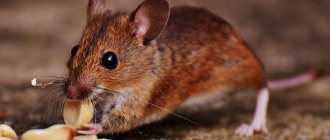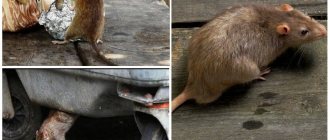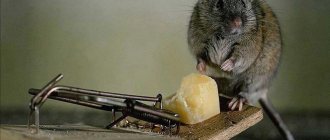Rodents are considered pests, but they harm humans not only by eating crops, plants and supplies, and by damaging buildings, furniture and household utensils. They can also be carriers of dangerous diseases. These animals are extremely curious and practically omnivorous. In search of food, they visit a variety of places, where they pick up pathogenic viruses, bacteria or fungi, and then transmit them to other animals or humans. Not only residents of rural areas, but also people living in cities can become infected from mice and rats.
How rodents become carriers of diseases
Rodents carry pathogens on their paws, fur, and teeth; they can leave pathogenic microorganisms on vegetables and fruits that end up on store shelves. So direct contact with rodents is not necessary to become infected with dangerous diseases.
There are several ways to catch diseases carried by rats and mice:
- through the bites of rats or mice, and they bite not only people, but also domestic animals, which become infected themselves and then infect their owners;
- pests gnaw root vegetables, other vegetables and fruits, leaving particles of saliva with pathogens on them;
- rodents leave their excrement on food and water, and it contains pathogens;
- rodent feces also dry out, crumble into small particles and mix with dust that can be inhaled by humans;
- Pathogens from rodents are carried by fleas, ticks, flies and other insects that live on them, which also bite humans.
A person can become infected with terrible and painful diseases of wild animals. Such diseases are usually called natural focal diseases. Their peculiarity is that in most cases, a sick person does not transmit their pathogens to other people and does not infect them. Infection occurs precisely from animals.
Prevention measures
Rats in the city.
It is very difficult to fight rats, so it is better to take timely measures to prevent their occurrence. To do this, you should adhere to the following recommendations:
- keep the area around the home in order and remove garbage in a timely manner;
- check the walls and roof of the room for through holes and eliminate them;
- get rid of sources of standing water on the site;
- get a cat or dog, giving preference to those breeds that are prone to hunting rodents.
What diseases can rodents carry?
Natural focal diseases, carried by rodents, have a different nature. They can be bacterial, viral, fungal. They often occur in a very severe form and can even lead to death.
The list of what diseases a person can become infected with from rodents is very long. We will only talk about the most common ones.
Leptospirosis
The disease is caused by Leptospira. Infection with them occurs in different ways, for example, through water or food with secretions of rodents. The incubation period can last from a couple of days to 28 days. The disease is characterized by a sharp increase in temperature up to 39 degrees, accompanied by severe headache and joint pain. A person suffers from insomnia. When moving, pain appears in the leg muscles. The face swells and turns red. A rash appears all over the body, and the skin may turn yellow. Leptospirosis causes liver and kidney failure, cerebral edema, problems in the cardiovascular system, hemorrhages and heavy bleeding.
Hemorrhagic fever with renal syndrome (HFRS)
It is also called mouse. This is a viral disease that can be transmitted through the air and by inhaling dust from rodent feces. People become infected with HFRS through direct contact with rodents, when dismantling old things or dilapidated buildings, excavation work, or eating food chewed by mice or rats.
The incubation period can last from one to seven weeks. The first symptoms are an acute, severe headache with chills and a sharp rise in temperature. There may be vomiting and nausea. Within a few days after the first manifestations of the disease, the face swells, turns red, the person becomes weaker, sleeps poorly, and is constantly thirsty. The vessels become brittle, hemorrhages, bleeding, and hemorrhagic rash in the form of small dots appear. A dangerous sign is pain in the lumbar region and impaired urine flow, which is caused by kidney damage. Complications of fever are cerebral and pulmonary edema, cerebral hemorrhages, cardiovascular failure, renal failure, kidney rupture, hemorrhages in the adrenal glands.
Pseudotuberculosis
Also called yersiniosis. An acute infectious disease caused by intestinal bacteria. The main carriers are rodents. A person can become infected through uncooked food, such as raw cabbage, apples or carrots. The incubation period is up to 18 days. The disease begins acutely, the state of health sharply deteriorates, weakness and headache, muscle, and joint pain appear. The temperature jumps to 40 degrees. Symptoms at first may resemble those of a cold: sore throat, runny nose, painful swallowing. A distinctive symptom of the disease is redness in different parts of the body: in the form of gloves, socks or a hood. A rash appears all over the body, and there may also be yellowing of the skin. All this is accompanied by disturbances in the gastrointestinal tract: nausea, vomiting, lack of appetite, diarrhea. Pseudotuberculosis leads to myocarditis and arthritis.
Tularemia
An infectious disease that occurs with fever, inflammation of the lymph nodes and internal organs. May affect the lungs, eyes, gastrointestinal tract, skin and other organs. The disease is caused by bacteria that can be carried by all types of rodents. A person becomes infected through water, food, animal excretions, and also by inhaling dust from feces. You can become infected through contact, for example, when catching rats or mice, skinning.
Symptoms of the disease appear one to three weeks after infection. First, the temperature rises sharply to 40 degrees. A person has a headache, he is shivering, his muscles and joints ache. Then the lymph nodes in different parts of the body enlarge: in the armpits, groin, neck, etc. Symptoms include tonsillitis and pneumonia. A person suffers from tularemia for two or three weeks, after which immunity to this disease is formed, but in rare cases there may be relapses.
There is a vaccine against tularemia; the vaccine is given to people whose work involves a risk of infection.
Other diseases
Also dangerous to the human body are the following diseases transmitted by rodents:
- Typhus - typhus or abdominal. It manifests itself as intoxication, rash, headaches, gastrointestinal disturbances, diarrhea and flatulence. Clouding of consciousness and even coma are also typical.
- Plague . Symptoms: severe fever, muscle pain, enlarged and inflamed lymph nodes, confusion, damage to internal organs, especially the lungs.
- Rabies . A very dangerous disease, the mortality rate if untreated reaches almost 100 percent. Symptoms: intoxication, attacks of excitement, abnormal reactions to stimuli, paralysis with a fatal outcome. Rabies causes encephalitis, an inflammation of brain tissue.
- Toxoplasmosis . Very dangerous for pregnant women. Causes intrauterine death, miscarriages, premature birth.
- Salmonellosis , leading to kidney or heart failure.
- Rickettsial infections with acute and severe fever.
Rodents are also carriers of a very unpleasant disease such as lichen.
Diseases indirectly transmitted by mice
Lyme disease, babesiosis
It is transmitted through ticks, which mice often get. Ticks easily transmit this very serious health hazard that has long-term consequences.
Babesiosis can be asymptomatic for some people and life-threatening for others.
Symptoms:
- fever;
- chills;
- sweat;
- nausea;
- fatigue.
Sometimes people experience vital organ failure and death. Dogs and cats also become infected with the parasite and show symptoms such as lack of energy, decreased appetite, enlarged abdomen, and discolored stools. The severity of the disease depends on the type of animal.
Plague
Bubonic plague (the bacterium Yersinia pestis) was thought to be caused by mice and rats, but turned out to be caused by the fleas they carried. Fleas feed on blood and transmit this potentially fatal disease.
House mice do not usually carry human plague (bubonic) because they have fewer flea infestations than rats.
It can now be easily treated with antibiotics if diagnosed early, but it is still a serious disease. Plague is relatively rare, affecting 1,000 to 2,000 people worldwide each year. Transmitted via:
- Touching an infected animal;
- Bite from an infected flea.
The most common symptoms of plague are:
- abdominal pain;
- diarrhea;
- nausea, vomiting;
- fever, chills;
- headache;
- muscle weakness.
An accurate diagnosis is made based on blood tests. Treatment includes the use of powerful antibiotics. There are vaccinations for people who are at constant risk of contracting the plague.
Learn more Can you tell the difference between Zika virus and Dengue fever?
Colorado tick fever
Another serious and life-threatening disease transmitted by ticks carried by mice.
Rickettsial pox
Rickettsial pox, murine typhus (endemic) is caused by the bacterium Rickettsia akari, similar to chickenpox. Transmitted by rat, cat, and mouse fleas. Spread by mice, but very rarely. The illness is usually mild and goes away in 2–3 weeks if left untreated.
No deaths were recorded. Endemic typhus responds well to antibiotic treatment.
Anaplasmosis
Ticks that transmit anaplasmosis are often carried by deer mice. A non-fatal disease that affects both people and pets.
Symptoms:
- chills;
- headache;
- muscle pain.
Pets exhibit loss of appetite, lethargy, and delayed movement.
Tularemia (rabbit fever)
Tularemia is a disease caused by a bacterium (Francisella tularensis) carried and spread by wild rodents (including muskrats , ground squirrels, beavers) throughout the world. In a disease caused by an insect bite, it causes an ulcer at the site of injury.
When infected while eating or drinking, the disease causes swelling of the glands, cough, and lung infection. Symptoms range from very mild to life-threatening. The final diagnosis is complex and requires blood tests.
Transmission to humans occurs through:
- Handling of carcasses of infected animals;
- Bites of infected insects such as ticks, flies;
- Consumption of contaminated food and water;
- Inhalation of air containing bacteria.
Once diagnosed, tularemia is treated with large doses of antibiotics. Symptoms may last for many weeks. The person recovers completely after treatment.
Prevention – Prevent insect bites with repellents, avoid direct handling of rodents, use respiratory protection to avoid inhaling landscape dust while gardening and agricultural work.
Treatment and prevention
To avoid contracting dangerous diseases, it is important to be careful and avoid contact with mice and rats. It is necessary to get rid of mice and rats in a private home or country house. Poisonous baits, for example, produced by the Russian company MediLIS Laboratory LLC, for example Mediret - bait or Mediret-combi, can help with this. They effectively help destroy rodents.
Under no circumstances should you eat foods with marks from rodent teeth. If there is a possibility that mice or rats have been running through the supplies, they should not be consumed without heat treatment.
When working in areas where there is a lot of dust and there may be animal feces, you need to protect your respiratory system.
At the first symptoms, you should consult a doctor. Almost all diseases can be successfully treated with antibiotics and other drugs, but only if they go to the hospital in a timely manner.
Disease Prevention
Anyone should know what risks they may face from contact with mice. This is not only damaged furniture and eaten food, but also a real threat to life and health.
Therefore, everyone must follow preventive measures:
- avoid direct contact with mice and their secretions;
- all work in old buildings where rodents live is carried out wearing gloves, respirators and protective clothing, which are then destroyed by burning or disinfected;
- under no circumstances should you eat foods that have traces of rodents;
- all food is kept in tightly sealed containers, inaccessible to small rodents;
- always wash your hands before eating and after any work;
- cleaning in old, dusty rooms is done only using a wet method using disinfectant solutions;
- keep houses, basements, courtyards and garden areas clean, and prevent the accumulation of garbage;
- periodically carry out deratization by all possible means;
- do not swim in bodies of water if there are prohibiting signs, especially you cannot relax in wild, unimproved water areas;
- It is forbidden to set up dumpsites in places not intended for this purpose - such landfills pose an epidemiological danger due to the uncontrolled reproduction of rodents.
- control over the sanitary condition of storage areas for vegetables, fruits and other food products.
In addition, the fight against rodents should be carried out at the state level: if local governments do not develop a rodent control program and follow its rules, then the population risks being exposed to outbreaks of terrible infections, including the plague.











